Our stay at Canso was marvelous. We anchored in a cove dotted with rocky islands, our only neighbors were Loons, Seals and Cormorants. They all watched us carefully as we anchored, and the minute you looked their way the seals would duck under water – almost like a game. Some of the more curious would edge closer to get a better look, but as soon as we looked they would disappear. After our nap Melanie cooked dinner, and we had a marvelous spread consisting of grilled Mackerel, mashed potatoes and veggies. The fish didn’t look that big, but we over estimated. The Mackerel did not shrink as much as other fish do when you cook them, they were more like a Tuna, meaty and delicious. By dinner’s end we were stuffed and after cleanup we went to bed. The cove was so calm we didn’t even rock, it was heavenly and we slept hard!
- Sunny but cold!
- Dotted with islands
- Dolphins!
- Sunset coming into Liscomb River
Next morning after breakfast we hauled anchor and picked our way out of the cove and between the rocky islands, then headed South West towards Halifax. We had a gorgeous wind from the NE which pushed us along quite nicely. We made good ground during the day, and saw a pod of Dolphins, a few whales and numerous Gannets fishing for dinner. It was a nice sunny day and even though it was chilly in the shade, we ended up peeling off all our warm weather clothes and basking in the warm sun. Later in the afternoon the wind fizzled completely, so we motored the last 2 hours until we came to the Liscomb River where we anchored for the night.
We pulled in right at sunset; Melanie cooked Haddock and veggies for us so we could eat early around 6, and by the time we were done with eating and cleaned up, we were pulling into the mouth of the river. This too was a gorgeous spot, rocky conifer lined shores with a few houses spotted here and there. We anchored in a cove off the main channel of the river and once again had a calm, restful night. The sky was clear and the heavens were littered with stars, the Milky Way looked like it was painted it was so bright – it was truly a beautiful sight.
Next morning the sun woke us, we ate breakfast and then hauled anchor to start the day. We motored out of the river, put up the sails and started to zig-zag our way to the next stop. Winds were light, but without the chop from powerboats like we encounter on the lake, we were able to make a good 4-5 knots in under 10 knots of wind. It was from the South West, our destination, so we had to zig-zag down the shore which was littered with numerous rocky islands and shoals. Every available flat rocky space was crowded with seals, who promptly took to the water when we got too close. They would watch us from a distance, carefully noting our progress away from them until they felt it was safe to climb up and sun themselves again.
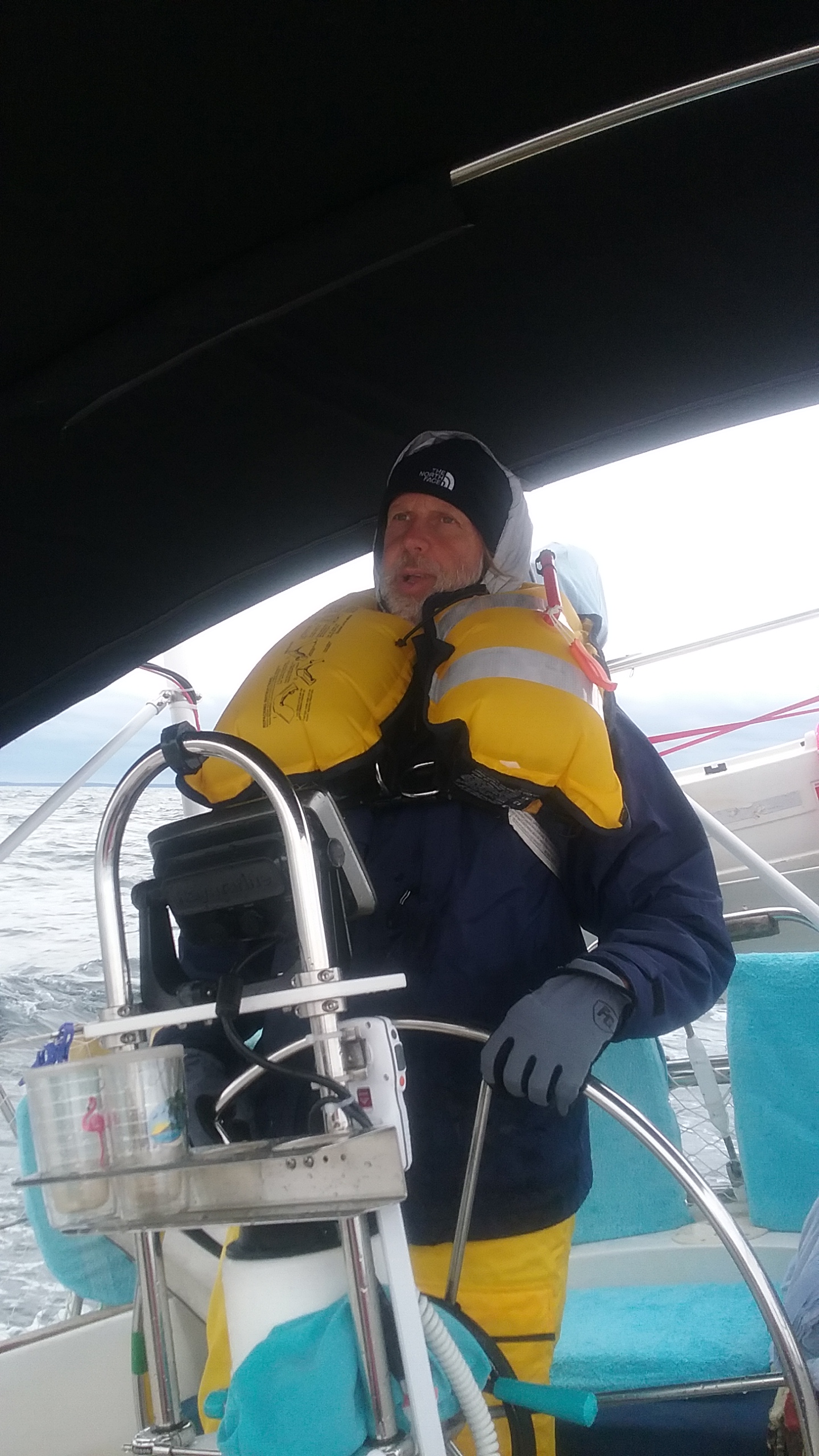
Hit by a wave, my life jacket went off!
The wind gradually increased during the day until it was in the 20 knot range. We still carried full sail and were moving along nicely between 5.5 and 6.5 knots. Towards evening I looked in Active Captain and found a cove nearby called Shelter Cove. It was on an island near the mainland and got good reviews for shelter and quality of scenery. We pulled in and dropped anchor in the cove; there was a trawler anchored there already, we had seen him leave in the morning from Liscomb. We dropped anchor a respectable distance away and Melanie made some more Mackerel for us to feast on. After a filling dinner we turned in for the night.
Shelter Cove was sheltered! It was very calm and the scenery was spectacular. We shared the cove with the trawler and some campers on land, and we were far enough apart that it felt like we were alone. The goal for the following day was Halifax; we wanted to get there ahead of the next storm coming up the coast. We motored out into a calm sea with swells gently undulating under us. It felt like the ocean was breathing; up, down, up down – ever so gently. Some of the swells were quite large, 8 ft or so, but they were so far apart that you didn’t really notice. Not much wind though and with a low fuel situation, I wanted to ensure we had enough to motor into the harbor, so we raised the sails and suffered. 1.9 knots, 1.5 knots – progress was painful, but the wind backed so it was more from behind and we were in a situation where we could fly our asymmetrical spinnaker. We hauled that baby up and got it set and our speed went up from 1.5 to 5! Its amazing how it helps your downwind speed – just that and the mainsail and our speeds were almost as fast as the apparent wind at 6.5 knots. We sailed along making good progress towards Halifax, and the skies gradually clouded up in advance of the oncoming storm.
- Spinnaker out!
- Life at an angle…
We sailed for a few hours and when we were about 15 miles from Halifax, the winds gradually died. Our speed dropped slowly; 4.5, then 4, then 3.5, then 2. So our 3 hours left to Halifax was now 6 hours and the weather was moving in. I tried to sail the boat more directly towards the harbor entrance which meant the wind was from behind – spinnaker on one side and mainsail on the other. That gave us a short boost in speed – all the way up to 3 knots, then the wind pooped even more and the sails were just flapping every time a wave passed under us. We took down the mainsail so the spinnaker was completely unblocked and that helped for a while, then the wind began to switch and it started to rain. We were now sailing away from our target, so we gybed the spinnaker, a long, painful process, and within minutes of doing that the wind came up to 10 knots and we were sailing with just the spinnaker at 7knots! We sailed into the Halifax harbor entrance until we were about 2 miles from our destination, then doused the spinnaker and fired up the engine to motor in.
We made contact with Marc, someone I met on facebook – he is part of the Cherubini group we belong to (our boat was designed by John Cherubini) and he also runs a group called Cruising Nova Scotia. He has the same model boat as us, only ours is a 79 and his is an 84. He motored out in his dinghy to meet us and guided us through the narrow channel to his mooring ball which he graciously let us use for the night. After tying up he climbed aboard and we chatted about our journey, our boats and toasted a new friendship with some Canadian Maple Whisky before turning in for the night.
- Leaving Eastern Passage, a fishing village where we stayed in Halifax
- Leaving EP
- Leaving EP
- Leaving EP
- Our gracious host Marc
- 2 Cherubinis hanging out
- Docked in EP
- Halifax Harbor
- A wedding in EP
- Halifax harbor
- Melanie with Marc and Elsie
- Holy Mackerel!
- Fisherman unloading Mackerel
- Lobster anyone?
- Eastern Passage wilderness
- Eastern Passage
- Eastern Passage
- Eastern Passage
- Eastern Passage
- Eastern Passage
We spent the next 3 days exploring the local area, land bound because of heavy unfavorable winds. The area where Marc lives is a little fishing village, and he got us a free dock with water and power behind his boat. The channel was quite narrow, so docking was a challenge, but we made it in safely and tied up and then spent the morning chatting before going out for a long walk which ended up in a dinner date. We shared a fisherman’s platter; 2 huge pieces of Haddock, 6 sea scallops and 4 huge shrimp along with chips and coleslaw. We were stuffed. After walking home we spent the evening with Marc and his girlfriend on their boat, enjoying a few drinks and getting to know them.
Next day we took a long walk on the boardwalk that runs on the shore from the village out to the beach, then we came home so I could work, and after dinner we entertained Marc and Elsie on our boat. It was his birthday; he was born the day before me in the Congo in 1959, so he is a day older. After they left, we listened to the Buckeye game on the radio before turning in.
Next day Marc ran me out to the Yacht Store (yachtshop.ca), and I hate to say it – they put West Marine to shame! Sailors take note – they have an online store and they ship to the US, orders over $99 have free shipping. It was cold and windy (30+) so we delayed our departure date until Sunday, and laid around watching movies all afternoon.
Sunday morning we rose early, took care of business and said our goodbyes. It was a calm, sunny day and we motored north into Halifax bay and around McNab Island to the Royal Nova Scotia yacht club for a pump out. WOW – there were some seriously large boats there, we felt quite puny in our 37 ft “dinghy”. There was a sailboat from Rhode Island there – every bit of 70 ft – this was the wealthy yacht club of Halifax for sure. We motored out of the channel and hoisted the sails, tacking back and forth into a South wind to get out of the harbor. Marc told us of a short cut – it was a well marked channel so we took it – and it saved us a good 2 hours given the wind direction. We were initially headed towards Lunenberg, but decided after looking at the weather forecast to try and go as far as we could, so we changed course and headed towards the Lahave River area. The wind gradually increased until we were in 20-25 knots, but we were on a close to beam reach (90 degrees from the front) so it was not too uncomfortable. The odd swell would hit you wrong and bounce you around a bit but we were able to hold speeds between 6.5 and 8 knots.
- Royal Nova Scotia Yacht Club
- Royal Nova Scotia Yacht Club
- Houses near the yacht club
- Houses near the yacht club
We arrived in Lahave and given the wind direction, anchored between 2 islands so they would block the wind and waves. To a large extent they did, but wrap around swells made sleeping that night rather uncomfortable until the wind switched to the south west. Right after sunset the clouds opened and it poured for a good few hours before letting up – we were thankful to be inside out of the weather.
Next morning we awoke, and after breakfast decided to move the boat into the lee of a larger island that would give us calmer water. We stayed in this area 2 nights because there was a gale warning issued and they weren’t kidding. We saw winds around 45mph, so moving the boat to a calmer spot was a good idea. Although we could hear the wind howling through the rigging all day, a soft moan that got a lot louder when the gusts hit, the water was very calm and so we enjoyed a sheltered day and night. I worked and we caught up on correspondence with family and friends. The sun did peek out and warm things up a little as well, so that helped raise our spirits.
- House in Lahave River
- Lahave River islands
One thing I do know, day after day after day of heavy unfavorable winds really wears you down, especially when its cloudy and cold. You have nowhere to go. You can’t go back to the dock which is now almost 1900 nm away, you just have to endure and hope that the next passage doesn’t beat you up too much and that the anchorage is sheltered enough that you will be able to rest. I do hate motoring, so some nice, warm trade winds in the 15 to 20 knot range would be great! Since leaving Quebec city, we have had very little in the way of that type of wind, for the most part it has been 20-30 and from forward of the beam, which makes for a pretty rough ride. Leaving Perce and leaving Canso we had a few hours of that type of breeze, but it has howled the rest of the time we were on the water. Nova Scotia is definitely WINDY!
- What the anchor dragged up
- Visitor in Lahave River, a C&C 30
And so, after watching a few DVDs on day one of our stay in Lahave River (we are going through “The Bible” series), and enjoying some sunshine in the late afternoon with mildly moderating winds in the low 20s, we turned in for the night. Our anchor spot was a good choice, the wind did come up again during the night and by morning it was howling at 30-35 again and the rigging was moaning in response, only this time we had fog and visibility was around a half mile! The waters were calm and protected in our chosen spot so we slept well, but once again we were held by the weather. Even the short distance (150 meters) between us and the shore was long enough to generate whitecaps. Our Destination is to the South West and the wind was 25-35 knots (30-40mph, or 48-65kmh) out of, you guessed it, the South West. So prudence reigned and we sat for another day in our sheltered anchorage. Sometime around late afternoon the previous day, we had a visitor. A C&C 30 sailboat pulled up behind us and anchored as well, we’re not sure where they came from but I am sure they were hiding from the weather as well.
The weather lived up to its billing, the fog burned off eventually, but the wind moaned and howled through the rigging all day long. After work we watched another movie and then turned in for the night. The wind did moderate, and in the morning we woke to 10 knot winds with pea-soup fog. This was the first time we had seen fog this trip. It was THICK!! We hauled anchor and motored out, measuring against a buoy on the chart how far we could see – our visibility was less than 300ft! Very disorienting as everywhere you looked was just bright white.
We motored out of the cove into a gently rolling swell; 6-8 ft swells about 150 ft apart, the left overs from the previous day’s gale. We put up sail and were able to make between 4 and 5 knots straight down the coast. The wind gradually faded away and the fog cleared out in the ocean; we were about 5 miles from shore. We had some bright sun but land was shrouded in a thick layer of fog. We reluctantly fired up the motor and started motoring. About 2 hours into our trip, the wind came up again, a solid 15-20 and close hauled we were able to make our mark for the next evening. We hoisted the sails and killed the motor and got in a good 4-5 hours of quality sailing. The wind however gradually shifted in the span of a half hour until we were headed almost perpendicular to our next stop, so we tacked and within 5 minutes of that we were headed back in the opposite direction away from our destination! Sails in, motor on. We motored the last hour or so and the fog rolled back in again with visibility around 200ft.
- Fog!
- Fog over land
- Thick fog!
- Carters Beach
- Carters Beach
- Carters Beach
- Carters Beach
- Carters Beach
- Carters Beach
Right as we were coming into the cove we got a couple of warm gusts of air off the shore and the fog lifted so we could see where we were headed. We slowly motored into the anchorage and dropped anchor at Carters Beach outside Port Mouton. It is known as the Bahamas of Nova Scotia and I can see why! The beach was creamy white sand and the water was that famous Bahamas Azure color. We anchored in about 20ft of calm, glassy water and I saw the anchor on the bottom – that’s how clear the water was! After setting the anchor, we dropped the dinghy in the water and motored in to the beach so that Windsor could stretch his legs. The sand was like flour; soft, white fine grains – warmed by the sun – it felt good to be in shorts and not dressed up like Shackleton!
After a good spell on the beach we came back to the boat around sunset and soon after that, the fog rolled in again, so we closed up the boat to keep the humidity out and were able to watch a DVD movie before turning in for the night. Next morning we woke – to dense fog and a howling wind as forecast. Winds were 25-35 knots which for us was good as we had issues with the batteries being charged. Our batteries had run down low enough that we had to hand crank the engine to start it! Turns out the controller which converts the electricity from the solar panels and the wind generator into power to charge the batteries was not working properly. The charging port was actually discharging the batteries! With the howling winds our batteries went from 13V down to 10.9V! There are direct power connections on the controller, so I hooked the batteries up to one of them and now our solar and wind are actually charging! The bad thing is I have to monitor the batteries to ensure that the direct connection does not overcharge them; I will have to disconnect the controller when they do get full. One thing we will have to replace in Norfolk I guess.
We went in to the beach to take Windsor for a walk after breakfast, and were able to refill our water jugs courtesy of a kind lady who saw our boat anchored in front of her beach front home. I came back and worked while the latest gale howled itself out during the course of the day. The fog lifted a bit in the late morning, but rain moved in so we were cooped up below while the wind shrieked and howled through the rigging all day. Late that night the wind finally blew itself out and after taking a walk on the beach the next morning, we hauled anchor and headed out. In thick fog. We rounded a huge island that we couldn’t see and the fog then lifted for just a minute or two. There was a fishing boat aground on the point of the island about 10 ft above the water, a sobering sight. Then the fog closed in again. We motored to Lockporte about 20 miles away and when we were about an hour from our destination, the fog lifted so we could see our way in.
- Lighthouse at Lockeport
- Lockeport entrance
- Lockeport – docked for fuel
- Lockeport – kelp forest growing on the docks
We fueled up, then motored out towards Brazil Rock on the South West corner of Nova Scotia. The wind was in our face, so no sailing, just motoring. The fog closed in once again about 10 miles from the rock, and that is where things got strange. We saw a sailboat on our plotter, and it looked like it was going around in circles. We thought perhaps there was a mechanical issue or worse yet, a man or pet overboard. We hailed them on the radio and there was no answer. We decided to investigate as they were about 10 miles offshore and if in trouble, we knoew they would appreciate the help. After unsuccessfully trying to contact them, we hailed the coastguard and told them the situation. They tried hailing them too without success. As we crept closer the boat started to move away from us, always remaining about a half mile away. This of course is happening in fog with about 100 yards of visibility.
After chasing them for a while, we hailed the coastguard and they told us to continue on our way, so we headed towards Brazil Rock again, and the other boat did too – converging courses. At one point we saw them briefly as they cut in front of us about 1/8 mile ahead of us, then they sailed parallel to us for about a half hour, just out of sight in the fog, every once in a while coming towards us, then swinging away. Almost like drunken sailing. We hailed the coastguard twice more to report in what was occurring, as we were a little wary. Then they dropped behind us and followed about a mile behind for a good 2 hours, and then slowly they dropped off our screen. We turned to the Northwest towards the coast of Maine, and they went Southwest. We were actually relieved, I had visions of piracy flitting through my head.
The night was calm, no wind but large heaving gentle swells lifted the boat as we motored through the fog. Next morning it was still foggy, and the wind was still a no-show. Late morning the fog lifted temporarily and then the wind came up for a short while. Then our trouble began. We smelled diesel and sure enough, the fuel filter housing on the engine was leaking diesel. We stopped the engine and drifted around for a half hour or so while I repaired the problem. We had the issue previously and I thought I had it fixed. So I did the same thing again. We started up the motor and no leak, so off we went.
An hour later, diesel smell, same thing. So I tried tightening the seal. We motored for about a half hour and then realized it was still leaking. Our filter was clogged so I thought it could be pressure buildup and I took the fuel filter out. Then I made the mistake of starting the engine before filling the fuel bowl with diesel, so I spent a half hour bleeding the lines to get going again, then realized that the leak was still occurring. We were about 50 miles from Maine, and once again stopped in the water. I took the fuel filter housing off and flipped the O-ring over. Then I greased it with vaseline. Still no luck. After motoring for about an hour, the fan belt wheel for the water pump fell off! Stop engine. Fix that. Start engine – now the leak was getting pretty bad, so we stuck a pot under the engine to catch the leaking diesel to help us figure out how bad the leak really was. We figured it was leaking about 3 gallons an hour, which would have run us out of fuel about 20 miles from shore.
- Storm clouds over Maine at sunset
- Dead calm! Fog!
- Dead calm! Fog!
The fog lifted thankfully and we could see storm clouds over the Maine coastline. So, I drove while dodging lobster pots, and Melanie caught diesel in the pot and used that to fill a bucket. Once we had a gallon, she would pass it up, we would stop, I would pour it into the tank and then we would be on our way again. We did that for 6 hours until we hit the 100ft water depth. Then the lobster pots got VERY thick – and we both had to be up, one to drive and one to spot pots. We made our way up a channel and anchored in the lee of the Cranberry Islands around 3am, exhausted but we made it. The boat stunk of diesel and we both had headaches from the fumes. We slept like babies and woke to a beautiful view the next morning; sunny with a cool breeze. Back in the USA and glad to be “home”!
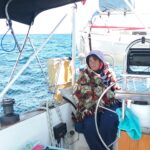
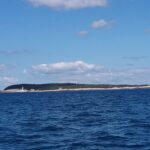
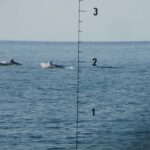
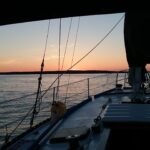
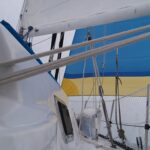
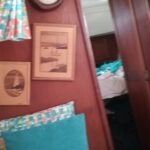
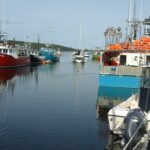
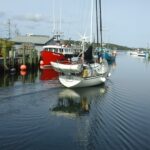
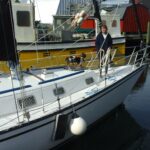
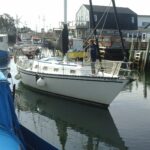
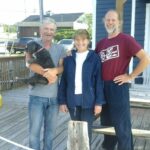
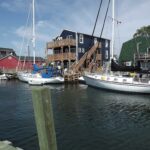
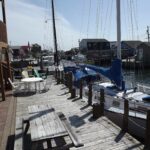
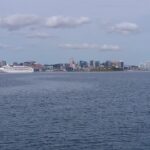
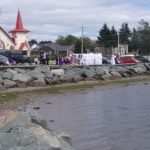
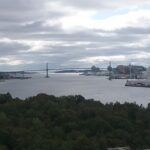
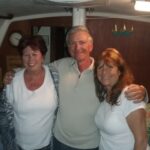
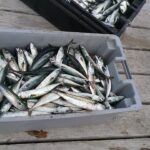
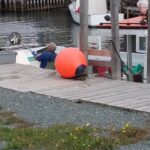
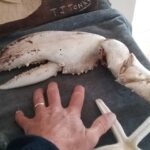
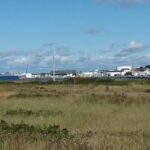
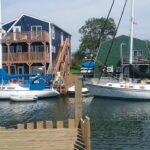
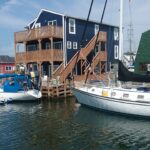
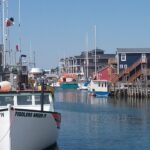
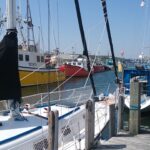
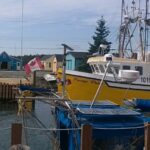
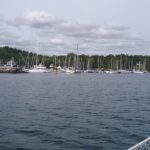
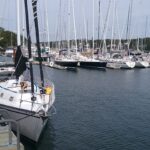
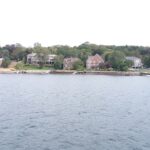
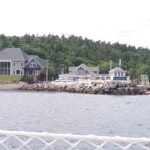
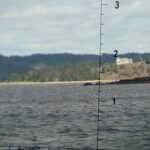
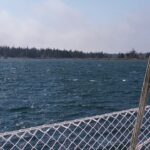
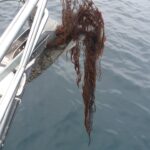
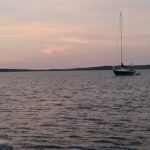
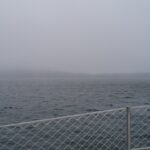
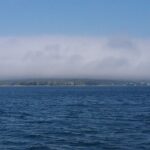
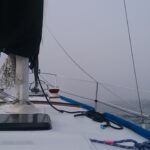
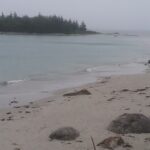
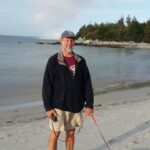
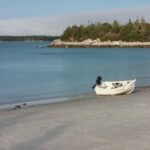
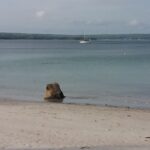
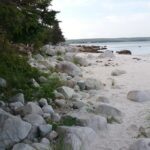
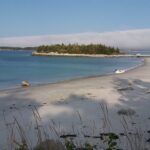
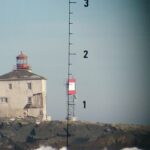
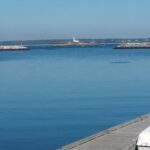
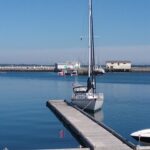
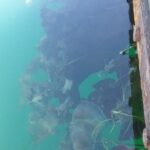
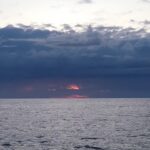
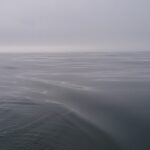
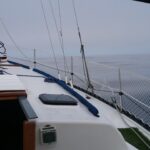
WOW! Glad you made it and were able to solve your engine problems. You’re never going to get fish and lobster like that again!!
We have been living on clams, mussels and Haddock. Its relatively cheap so its hard to turn it down!